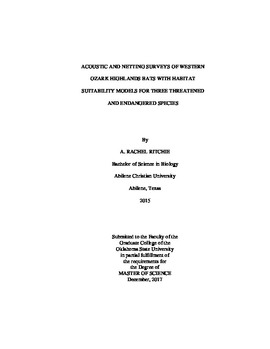| dc.contributor.advisor | McBee, Karen | |
| dc.contributor.author | Ritchie, Anna Rachel | |
| dc.date.accessioned | 2018-06-25T16:31:26Z | |
| dc.date.available | 2018-06-25T16:31:26Z | |
| dc.date.issued | 2017-12-01 | |
| dc.identifier.uri | https://hdl.handle.net/11244/300314 | |
| dc.description.abstract | Bats in the United States and Canada are experiencing major population declines because of white-nose syndrome (WNS), a fungal disease that kills bats hibernating in caves. First discovered in New York in 2006, WNS has rapidly spread south and west across the United States. Camp Gruber Training Center (CGTC) is a United States National Guard training facility in Muskogee County, Oklahoma. Muskogee County is adjacent to three counties that are suspect for WNS infection as of 2017. I performed acoustic and mist net surveys at CGTC to determine composition of the chiropteran community of the area and if bats in Muskogee County have been exposed to WNS by looking for characteristic damage on wing membranes. Acoustic and mist net surveys determined that the bat community of CGTC is likely dominated by non-endangered species that have not suffered high mortality from white-nose syndrome (Nycticeius humeralis and Lasiurus borealis). There are at least 2 species that occur rarely within CGTC that are federally endangered (Myotis grisescens and Myotis sodalis) that, along with the non-endangered Perimyotis subflavus, have been known to contract WNS. I found no evidence of WNS symptoms on the bats of CGTC as of summer 2017. I used maximum entropy species distribution modeling (Maxent) to create habitat suitability models for three species that occur in the Ozark Highlands around CGTC, Myotis grisescens (endangered), M. septentrionalis (threatened), and M. sodalis (endangered). These models help explain the community composition of CGTC by revealing habitat preferences of these species and may suggest future range expansions or possible locations of unknown colonies for all three species. I also found that M. septentrionalis and M. sodalis are highly similar in their habitat preferences, supporting the United States Fish and Wildlife Service decision to combine summer survey guidelines for these species. | |
| dc.format | application/pdf | |
| dc.language | en_US | |
| dc.rights | Copyright is held by the author who has granted the Oklahoma State University Library the non-exclusive right to share this material in its institutional repository. Contact Digital Library Services at lib-dls@okstate.edu or 405-744-9161 for the permission policy on the use, reproduction or distribution of this material. | |
| dc.title | Acoustic and Netting Surveys of Western Ozark Highlands Bats with Habitat Suitability Models for Three Threatened and Endangered Species | |
| dc.contributor.committeeMember | Papes, Monica | |
| dc.contributor.committeeMember | Bolek, Matthew | |
| osu.filename | Ritchie_okstate_0664M_15523.pdf | |
| osu.accesstype | Open Access | |
| dc.description.department | Zoology | |
| dc.type.genre | Thesis | |
| dc.type.material | text | |
